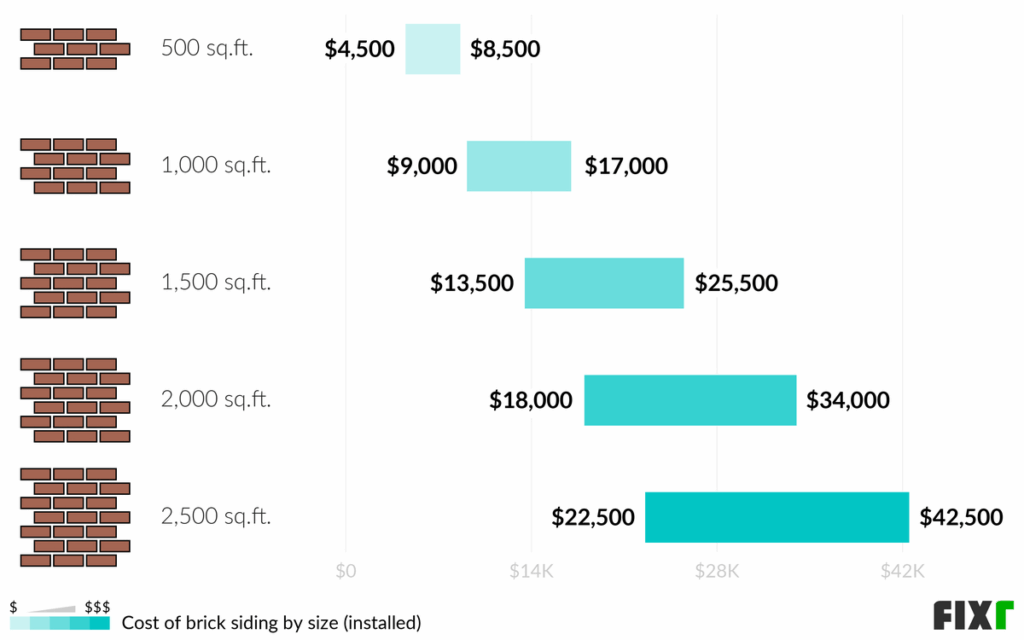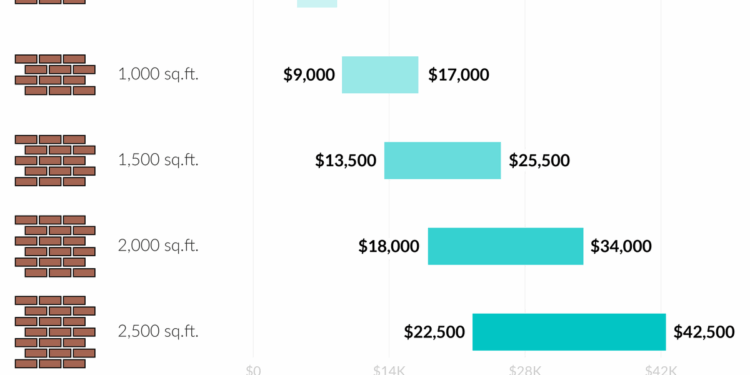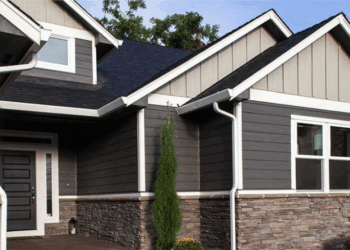
Delving into the realm of siding cost per square foot installed, we uncover the intricate details that influence pricing, material choices, labor expenses, and more. Get ready to embark on a journey that sheds light on the nuances of siding installation costs.
As we navigate through the various elements affecting siding cost per square foot installed, a clearer picture emerges of the factors shaping this essential aspect of home improvement projects.
Factors influencing siding cost per square foot installed
When determining the cost of siding installation per square foot, several key factors come into play. These factors can significantly impact the overall cost of the project, making it essential to consider them when planning for a siding installation.Material Quality:The quality of the siding material chosen for the project can have a significant impact on the cost per square foot.
Higher quality materials, such as fiber cement or natural wood siding, tend to be more expensive upfront but can offer better durability and aesthetic appeal in the long run. On the other hand, vinyl siding is a more cost-effective option but may require more frequent maintenance and replacement.Labor Costs:Labor costs also play a crucial role in determining the overall cost of siding installation.
The skill level of the laborers, as well as their experience and location, can all affect the labor costs associated with the project. Additionally, the size and complexity of the project can impact the amount of labor required, further influencing the final cost.Location:The location of the property can also impact the cost of siding installation per square foot.
Factors such as accessibility, local building codes, and the availability of materials and labor can all contribute to variations in pricing. Urban areas with higher costs of living may have higher labor rates, while rural areas may have limited access to certain siding materials, affecting overall costs.Project Complexity:The complexity of the siding installation project can significantly impact the cost per square foot.
Projects that require intricate designs, custom fittings, or additional structural work will likely incur higher costs compared to straightforward installations. Additionally, factors such as the need for insulation, trim work, or removal of old siding can also contribute to the overall project cost.Overall, it is essential to consider these factors when budgeting for a siding installation project, as they can greatly influence the final cost per square foot.
Comparison of Siding Materials Based on Cost
When considering siding materials for your home, it's essential to factor in the cost per square foot installed. Different materials come with varying price ranges, durability levels, maintenance requirements, and aesthetic appeal. Understanding these factors can help you make an informed decision that suits your budget and preferences.
Vinyl Siding
- Average Price Range:Vinyl siding typically costs between $2 to $7 per square foot installed.
- Durability:Vinyl siding is known for its durability, resisting rot, moisture, and insects.
- Maintenance Requirements:Low maintenance, requiring occasional cleaning with soap and water.
- Aesthetic Appeal:Available in a wide range of colors and styles, offering versatility in design.
Wood Siding
- Average Price Range:Wood siding can range from $5 to $10 per square foot installed.
- Durability:Wood siding is prone to rot and insect damage if not properly maintained.
- Maintenance Requirements:Regular painting or staining is necessary to preserve the wood and protect it from the elements.
- Aesthetic Appeal:Natural and timeless look, enhancing the overall curb appeal of a home.
Fiber Cement Siding
- Average Price Range:Fiber cement siding typically costs between $6 to $12 per square foot installed.
- Durability:Highly durable, resistant to fire, rot, and pests.
- Maintenance Requirements:Requires periodic painting to maintain its appearance and protect against moisture.
- Aesthetic Appeal:Mimics the look of wood or stucco with less maintenance required.
The initial cost of the siding material can have a significant impact on long-term maintenance and replacement expenses. While vinyl siding may have a lower upfront cost, it could require more frequent replacements compared to fiber cement siding, which has a higher initial cost but lower maintenance needs.
Consider your budget, maintenance capabilities, and aesthetic preferences when choosing the right siding material for your home.
Labor costs and installation considerations
Labor costs are a significant factor in determining the overall cost of siding installation per square foot. Understanding the typical labor expenses associated with siding installation and how they can vary based on factors like experience, location, and project size is crucial for accurate budgeting.
Typical labor expenses for siding installation
- Hourly rates: Labor costs are often charged on an hourly basis by contractors. Rates can vary depending on the contractor's experience and the complexity of the project.
- Project size: Larger projects may require more labor hours, resulting in higher labor costs. Smaller projects, on the other hand, may be more cost-effective in terms of labor.
- Location: Labor costs can vary based on the geographic location of the project. Urban areas with higher living costs may have higher labor rates compared to rural areas.
Tips for finding reputable contractors and obtaining accurate labor cost estimates
- Research and compare: Take the time to research and compare multiple contractors in your area. Look for reviews, ask for referrals, and compare quotes to ensure you are getting a fair price.
- Get multiple estimates: Obtain detailed estimates from different contractors to compare labor costs and ensure transparency in pricing.
- Check credentials: Verify the credentials and experience of the contractors you are considering to ensure they are qualified to handle your siding installation project.
- Ask about additional costs: Inquire about any potential additional costs that may arise during the installation process to avoid unexpected expenses later on.
Additional costs and considerations
When budgeting for siding installation, it's essential to consider the potential additional costs that may arise throughout the project. These costs can include permits, disposal fees, trim work, insulation, as well as other unexpected expenses. Factors such as architectural details, removal of existing siding, and the need for repairs can also impact the total project cost significantly.
Potential Additional Costs
- Permits: Depending on your location, you may need to obtain permits for your siding installation, which can add to the overall cost.
- Disposal Fees: Properly disposing of old siding materials may incur additional fees, especially if hazardous materials are involved.
- Trim Work: Adding decorative trim or finishing touches to your siding can increase the cost of installation.
- Insulation: Upgrading or adding insulation during the siding installation process can improve energy efficiency but will also add to the project cost.
Impact of Architectural Details and Repairs
- Architectural Details: Complex architectural features or unique designs on your home may require custom siding solutions, leading to higher costs.
- Removal of Existing Siding: The removal of old siding can be labor-intensive and time-consuming, impacting the overall project cost.
- Need for Repairs: If underlying issues are discovered during the siding installation, such as rot or water damage, repairs will need to be addressed, adding to the total expense.
Recommendations for Budgeting
- Set aside a contingency fund: Budgeting an additional 10-20% of the total project cost for unforeseen expenses can help cover unexpected costs that may arise.
- Get multiple quotes: Obtain estimates from different contractors to compare prices and ensure you are getting a fair deal.
- Communicate openly with your contractor: Discuss potential additional costs upfront and establish a clear understanding of the project scope to avoid surprises later on.
Last Word
In conclusion, the world of siding cost per square foot installed reveals itself to be a dynamic landscape where choices, considerations, and costs intertwine to shape the outcome of a project. Whether it's selecting the right material, estimating labor expenses, or planning for unforeseen costs, the journey of siding installation is filled with opportunities for informed decision-making and strategic planning.
FAQ Overview
What are the key factors influencing siding cost per square foot installed?
The key factors include material quality, labor costs, location, and project complexity, all of which contribute to the overall cost of siding installation.
How does the initial cost of siding material impact long-term maintenance expenses?
The initial cost determines the durability and maintenance requirements of the material, which can affect long-term maintenance and replacement expenses.
What are some typical labor expenses associated with siding installation?
Labor costs can vary based on factors like experience, location, and project size. It's crucial to research and obtain accurate labor cost estimates from reputable contractors.
What are some potential additional costs involved in siding installation?
Potential additional costs may include permits, disposal fees, trim work, insulation, and unforeseen expenses like repairs or architectural details.
How can one address cost overruns during the siding installation process?
It's advisable to budget for unforeseen expenses, work with reputable contractors, and stay proactive in managing the project to address any cost overruns effectively.











